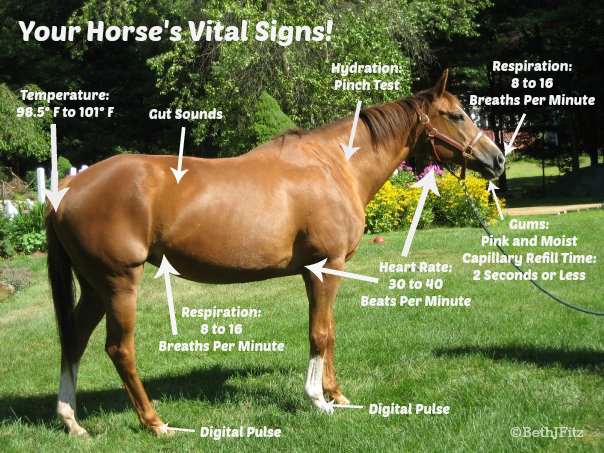|
Your horse’s vital signs are a very important resource for you and your vet! Knowing how to take them and knowing what is “normal” can be very helpful information, especially when dealing with a sick horse or in an emergency situation.
Temperature Adult Horse: 99°F – 101°F Foal: 100°F – 102°F How do I take the temperature? The horse’s temperature is taken rectally. You can use a digital thermometer or traditional mercury thermometer. Digital thermometers tend to be faster – which can be helpful when poking around the hind end of a horse that is not feeling well. When using traditional mercury thermometers, you need to make sure that it stays in the rectum for at least 3 minutes to get an accurate reading. If you are unable to hold onto the thermometer for the entire time, you should make sure that the thermometer has a string attached to it so the thermometer can be tied to the tail so it won’t get “lost.” Gums The gums should be pink in color and moist to the touch. If they are abnormal in color (white, red, purple or yellow) please call your vet as soon as possible! This is also where you can check out your horse’s capillary refill time. How do I look at their gums? Lift up the top lip of your horse and check all areas above the teeth. How do I find or figure out the capillary refill time? After lifting up your horse’s top lip, take your index finger and press on your horses gums above their teeth. When you remove your finger from their gums, you will be able to see a color change exactly underneath where your finger was. It should take less than 2 seconds for the gums to go back to “normal” color after you lift your finger. Heart Rate Adult Horse: 30-40 beats per minute Foal: 60-110 beats per minute How do I find the heart rate? There are a couple of ways to find your horse’s heart rate: 1) Listen with a stethoscope behind the left elbow on the girth area, or 2) Feel for a pulse on the lower jaw bone (lingual artery). For both ways, count the number of beats for 15 seconds, then multiply that number by 4. Respiration Rate Adult Horse: 8-16 breaths per minute Foal: 25-60 breaths per minute How do I find the respiration rate? There are a couple of ways to figure out your horse’s respiration rate. The two easiest and fastest ways are: 1) Watch the flank move in and out (in and out equals one breath), watch the nostrils flare in and out (in and out equals one breath). Gut Sounds A healthy horse gut is usually making some sort of noise! How do I listen to their gut? With a stethoscope (or your ear), listen to their abdomen on both sides, top and bottom. You should hear all sorts of sounds: gurgling, growls, tinkling, roaring, etc. Long periods of silence or no sounds at all can mean that there is a lack of movement in the gut that can lead to or indicate colic. Hydration A simple “pinch test” can be performed on your horse’s neck to see if your horse is hydrated or dehydrated. How do I perform a pinch test? Simply, pinch the skin on the neck near their shoulder. If their skin goes back to normal within 2 seconds, the horse is hydrated. If the skin stays “pinched” or raised for longer than 2 seconds, they are dehydrated. Digital Pulse The digital pulse is used to tell if there are issues directly related to the hoof or lower extremities. In a normal or healthy horse, the digital pulse is usually very faint and in some cases very hard to even find. The cause for concern is when you can clearly feel and easily find a digital pulse as this usually means that there is an issue. If there is a bounding digital pulse in one leg, then the issue may be isolated to that one area. If the digital pulse can be felt in more than one leg, then the issue may be systemic. How do I find the digital pulse? The digital pulse can be found on all four legs, near the fetlock. It can be very hard to feel so practice or feeling for it routinely can help you know the horses “normal” digital pulse. In most horses there is a groove running down the outside of their pastern (in between the coronet band and fetlock). This groove contains the artery you will feel for. As mentioned above, if the digital pulse can be easily found and is bounding, then there is most likely an issue. Take Home Message Vital signs are very helpful tools and should be one of the first things evaluated if there are any concerns. Be sure to have a thermometer, stethoscope, and emergency phone numbers readily available in your barn. If your gut instinct is to call the vet … call the vet! Also, do not administer any medications to your horse without consulting your veterinarian first! Administering medications can alter your horse’s vital signs and mask the immediate medical issue making it harder to diagnose or treat. Posted by BethJFitz
2 Comments
|
Archives
November 2023
Categories
All
|

 RSS Feed
RSS Feed